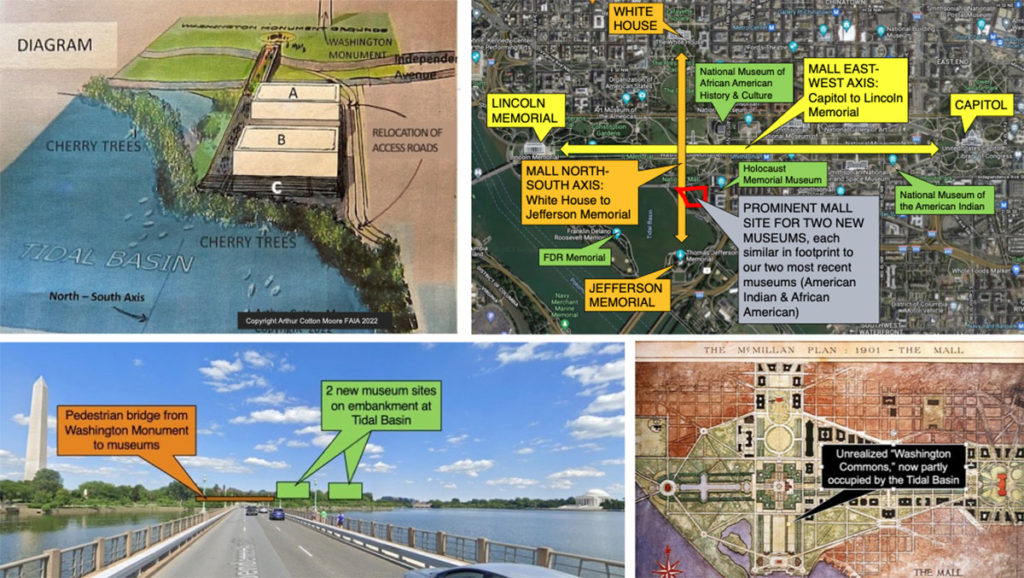By Judy Scott Feldman, PhD
NOTE: This blog includes diagrams to illustrate the Coalition’s Opinion piece published in The Washington Post on March 4, 2022.
The Smithsonian is trying to identify locations for two new museums in Washington, DC – the National Museum of the American Latino and the Smithsonian Women’s History Museum. Where will they go? In the authorizing legislation Congress identifies (in Sec. 8) several potential sites on or near the Mall. One prime option under consideration is to repurpose the historic Arts and Industries Building next to the Smithsonian Castle, but that building would be difficult to upgrade to modern museum standards.
The National Mall Coalition has a better idea.

Renowned local architect Arthur Cotton Moore FAIA has devised a compelling and viable solution for two new museum sites on the Mall. Mr. Moore has a long and respected reputation in Washington, having worked on innumerable new and preservation projects, including renovation of the Library of Congress. He is a long-time vice chair of the Coalition.
The side-by-side new museum sites are located along the Mall’s historic north-south axis, as defined by the 1791 L’Enfant Plan and the 1901-2 McMillan Plan – the blueprints for the National Mall. The north-south axis extends from the White House to the Jefferson Memorial; it intersects, at the Washington Monument, the east-west axis from the Lincoln Memorial to the Capitol.
Mr. Moore’s two sites, marked A and B on the illustration below, would create a new pedestrian destination on what is poorly utilized Mall acreage south of the Washington Monument. The attached diagrams illustrate the concepts.
This area currently is occupied by criss-crossing access roads; those roads can be relocated. Since flooding is a serious concern at the Tidal Basin, the new sites would be raised on an embankment, marked C. A pedestrian bridge elevated over the roads running between the Washington Monument and Tidal Basin would correct the existing dangerous pedestrian crossing.
Importantly, Mr. Moore’s concept creates two plots, each about the size of the American Indian Museum, that not only are located on the existing historical Mall, they in effect complete an unrealized “Washington Commons” element of the historic McMillan Plan that envisioned a lively cultural destination on this land but which, with creation of a large Tidal Basin, never was realized. Instead, the modern automobile took over this valuable Mall space.
The museum sponsors have a difficult choice, to try to find space on the already full Mall or to locate somewhere else in the capital. We agree with the 24 members of the Senate who wrote Smithsonian Secretary Bunch on November 22, 2021, that the museums belong on the Mall in order to highlight “the untold and overlooked contributions” of both women and Latinos.
The Senate’s letter, however, is mistaken in one important respect. It states, “From our perspective, the National Mall is the two-mile park from the Capitol to the Lincoln Memorial, bounded on the north and south by Constitution and Independence Avenues.” This definition is inconsistent with the historic L’Enfant and McMillan plans’ vision of the Mall as a unified landscape laid out across two axes, with the Washington Monument at its heart. Mr. Moore’s proposed museum sites are exactly consistent with, and reinforce to important effect, the historic concept of the Mall cross-axis connecting the iconic symbols of American democracy.
Ultimately, any long-term solution for future Mall development, and the inevitable future museums and monuments, is for Congress to charter a new McMillan-type commission to update the 1901-2 McMillan Plan. A new comprehensive, forward-looking vision could once again expand the Mall’s boundaries, as the McMillan Plan did over a century ago to include the Lincoln Memorial, and give new breathing space for the Mall to grow along with our ever-evolving democracy.
For now, Arthur Moore’s idea reveals a new opportunity for enhancing an underutilized area of the existing Mall, and provides an ingenious solution to enhancing the American story on this beloved stage for our democracy.
Tags: museums, National Museum of the American Latino, Women's History Museum
